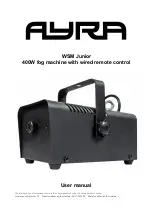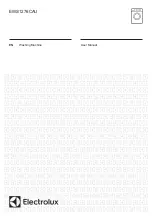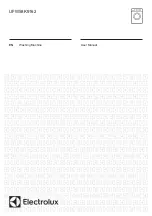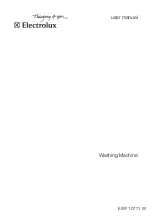
The position of the fold
table paper stop deter-
mines the location of each
fold in the paper. The sim-
plified fold chart (Item
64A) located on the exit
table (Item 64) provides
paper stop settings for five
standard cut paper sizes.
Two are metric (A3 &
A4), and three are inch (8
1/2 x 11, 8 1/2 x 14, 11 x
17).
The fold chart refers to “1st”, which corresponds to paper stop
settings on the first/upper fold table, and “2nd”, which corre-
sponds to paper stop settings on the second/lower fold table.
The letters on the fold chart correspond to the letter position on
the fold indicator rulers. The paper stop pointers should be set
so they bisect the circle of the appropriate letter setting.
Any paper size not shown on the fold chart up to 14" x 18" can
be set on the fold tables by following this procedure. Hand-fold
the sheet into the required fold. Measure the distance between
each fold. Set the paper stops on the first and second fold tables
according to measurements.
To position, or reposition the paper stop on the fold table,
loosen the locking
knobs on top of the
nylon split nut by two
full turns counter-
clockwise. A spring
under each split nut
helps disengage the
split nut from the
micrometer rod
threads. Place the
thumb of your left
hand on top of the left locking knob and the thumb of your right
hand on the right locking knob. With the index and middle fin-
ger of each hand, grasp the split nut for control. Slide the paper
stop assembly parallel along the micrometer rods to the required
fold location/measurement. Release the split nut and retighten
the locking knob.
CAUTION: Make sure the split nut is correctly
meshed with the rod threads before locking into posi-
tion. Failure to do so may damage the nut or threads.
Make fold corrections by loosening the locking knobs 1/4 to 1/2
turn. Move the appropriate micrometer wheel in the direction
indicated. Retighten the locking knob.
NOTE: Variations in folding speed will affect fold con-
sistency. Make sure corrections are made at the
speed you intend to fold. If folding is interrupted,
return the speed control to its previous position.
Always clear the conveyor and exit table of folded
material after an interruption. Failure to do so may
cause stacking problems when folding is resumed.
4.2.4 Setup Of The Feed Table Backstop
The feed table backstop is a one inch angled aluminum fixture
with a magnetic strip attached to one side. The feed table back-
stop should be used when processing 8 1/2" x 11" (A4) or
smaller stock to prevent sheets from being blown back from the
vacuum roller. Place the magnetic side of the backstop on the
feed table so the vertical side is set against the tail (back) end of
the paper stack.
4.2.5 Setup Of The Stacking Wheel Assembly
The stacking wheel assembly is located at the rear/exit side of
the folder. The function of the stacking wheels is to arrange the
exiting material from the folder into an overlapping stream on
the conveyor table. Generally, the stacking wheels should be
positioned about one inch from the edge of the sheet after the
sheet has dropped to the conveyor table.
NOTE: Increasing or decreasing folding speed may
require repositioning the stacking wheel assembly.
The assembly consists of the following. A square shaft with a
compression spring on one side. An angled deflector plate is
attached via two screws to the front of the square shaft. The
stacking wheel shaft extends outward from the center of the
square shaft. Mounted on the stacking wheel shaft are the axle
box housing, the stacking wheel axle, two stacking wheel
weights, and four stacking wheels.
There are two sets of stacking wheel assembly mounting holes
located in the machine side frame, directly in front of the upper
accessory shaft. To mount the assembly, insert the spring end of
the square shaft into one of the two holes in the side frame
(operators' side). Apply pressure (pull) the square shaft laterally
toward the spring end of the shaft. As you do so, align the other
end of the square shaft with the corresponding hole in the other
side frame and release pressure.
To remove the stacking wheel assembly, apply pressure (pull)
the square shaft laterally toward the spring end of the shaft.
Doing so will pull the other end of the square shaft from the
side frame. After the end is clear of the side frame, pull the
entire assembly out of the machine.
For most folding jobs, the deflector plate faces upward. To help
eliminate nesting and to improve the stacking of short folds and
heavier paper stocks, the deflector plate should be faced down-
ward. To do so, remove and reverse (turn over) the stacking
wheel assembly. The deflector plate can also be fine adjusted by
loosening the two mounting screws in the square shaft and low-
ering the slotted deflector plate up to 1/8". When using the
stripper wire the deflector plate must be removed and the stack-
ing wheel assembly should be installed in the inner set of holes.
The stacking wheel hook is located on the 1/2" tie rod, below
the first/upper fold table. Use of the hook is necessary when
perforating, scoring, or slitting sheets longer than 12". Simply
rest the stacking wheel shaft in the curved section of the hook.
6
Fig. 7
Fig. 8
Содержание 959AF
Страница 18: ...18 Parts Diagram 1 ...
Страница 19: ...19 ...






































